Volvo XC70 Third generation
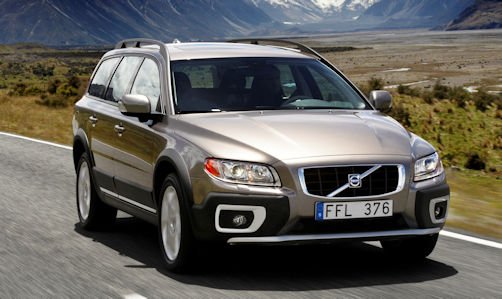 |
|
|
Production period: |
2007 to 2016 |
|
Body versions : |
station wagon |
|
Engines: |
Gasoline: 2.0-3.2 liters (175-224 kW) |
|
Length: |
4838 mm |
|
Width: |
1861 mm |
|
Height: |
1604 mm |
|
Wheelbase : |
2815 mm |
|
Curb weight : |
1821-1844 kg |
The Volvo XC70 third generation of Volvo’s capable cross-country model was introduced in the summer of 2007..
History
The XC70 was initially only with the largest gasoline engine and the stronger of the two five-cylinder diesel available, but with standard all-wheel drive (AWD).At the tuning fair SEMA in the US Volvo presented the study Volvo XC70 Surf Rescue , which is designed specifically for lifeguards . This study has 12 cm more ground clearance, fender flares, aluminum underbody mudguard, neoprene seat covers and a roof rack for rescue surfboards.
The large dark-coloured plastic panels on the previous XC70 model have now been mostly replaced with painted surfaces.
Engines
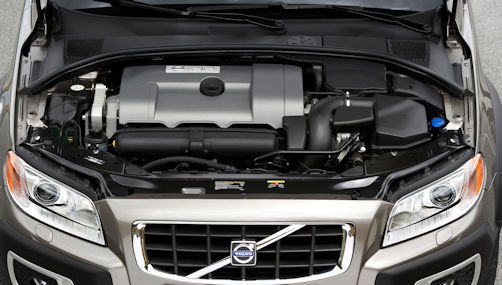
six cylinders and a displacement of 3.2 litres. The six-cylinder normally aspirated engine producing 175 kW (238 hp) and 320 Nm.The engine has an advanced valve mechanism featuring dual cam profiles on the inlet side. With CPS (Cam Profile Switching), as the system is known, the inlet valves can be raised to two different heights depending on engine revs and load. In normal driving, with normal throttle activation and low engine revs, fuel consumption is minimised at the same time as there is sufficient torque for good driveability. In addition, the engine features VIS (Variable Intake System). It consists of two throttle valves that adjust the volume of the inlet manifold to suit the current driving conditions and allow the engine’s capacity to be exploited to the very maximum throughout the rev range. In the XC70 are installed transversely, even the six-cylinder unit. This has been made possible owing to an extremely compact construction.The six-cylinder in-line engine’s compact format has been achieved by positioning ancillaries such as the power steering pump and air conditioning compressor behind the engine in the space above the gearbox.
Turbodiesel in-house manufactured second-generation D5 five-cylinder diesel engine is available in two versions. The more powerful variant offers 400 Nm of torque. Compared with the first generation, the new D5 engine featuring a new electronically controlled turbocharger, more advanced multi-point injection technology and a particularly powerful engine management system. A service-free particle filter is standard.
Engines are mated to a six-speed gearbox, manual or automatic with Geartronic. They are designed to handle the huge power of these engines. With Geartronic it is also possible to change gear manually.
Suspension and brakes
Power Parking Brake is standard, electrically operated parking brake system known as Power Parking Brake. If the parking brake is engaged at traffic lights, for instance, it is automatically disengaged when the accelerator is pressed and the car moves off. Please note that the driver’s safety belt must be secured for this function to operate.
The parking brake is engaged by pushing a lever to the left of the steering wheel and disengaged by pulling the lever.
To ensure that the parking brake is applied when the car is parked, it is automatically engaged when the key is removed from the ignition switch or, if the car is equipped with Keyless Drive, when the door is opened. This function must be selected initially in the car settings menu.
DSTC (Dynamic Stability and Traction Control) is standard. This is a stability-enhancing system that when necessary reduces engine torque and applies carefully calculated braking power to reduce the risk of a skid. By combining systems such as Four-C, AWD and DSTC.
Active chassis with Four-C optionally specified with an active chassis based on Volvo’s Four-C technology. It is an advanced self-regulating chassis system that uses a number of sensors to continuously monitor the car’s behaviour. The dampers are adjusted to suit the current driving conditions in mere fractions of a second.Four-C adjusts chassis settings to match the car’s speed. The higher the speed, the firmer the damping. This makes the car easy to control even at high speeds.
Three alternative chassis settings at the touch of a button allow the driver to alter the car’s driving character to suit his or her personal taste.
• COMFORT provides pleasant, comfortable progress with calm, harmonious body movements.
• SPORT provides more controlled body movements, faster steering response and a higher degree of road contact.
• ADVANCED gives minimum damper movement and maximum contact between tyres and road surface. It’s the setting for enthusiastic driving on smooth and flat asphalt.
Inside
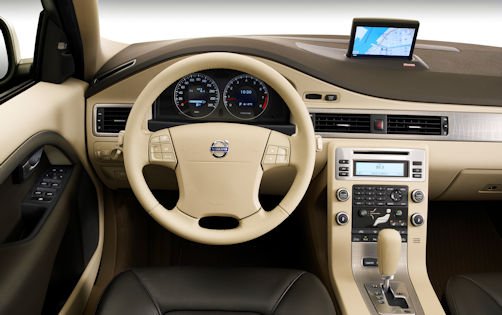
Increased legroom, more spacious and more comfortable than its predecessor. The distance from front to rear passengers has been extended by 21 millimetres, rear legroom by 48 millimetres and rear knee clearance by 21 millimetres, width at shoulder height has been increased by 30 millimetres in the front seats.Power-adjustable seats are available as an option, and they can be equipped with perforated and ventilated leather upholstery. These seats are equipped with fans in the seat and backrest cushions. The temperature in the cushions is lowered on hot days and in humid climates.The opposite effect heating of the front seats when the weather turns chilly – can be selected at a choice of three temperature settings. The rear seat too can be specified with heating, which includes separate switches for each of the two outer seats and, as in the front seats, three temperature settings.
Volvo XC70 can be equipped with the Clean Zone Interior Package, a system that is based on ECC (Electronic Climate Control) and IAQS (Interior Air Quality System).When the car is unlocked using the remote control, the passenger compartment is automatically ventilated for about a minute if the outdoor temperature is higher than 10 degrees Celsius.
Settings are altered in the car’s information system. The menu includes the seats, rear-view mirrors, climate unit, audio unit, navigation system. One of the selectable functions is automatic operation of the rear defroster. When this setting is chosen, the defroster is automatically activated when outside temperature is about 9 degrees C. Another example is the speed-dependent power steering. It is an option and can be set at one of three levels via the information system.
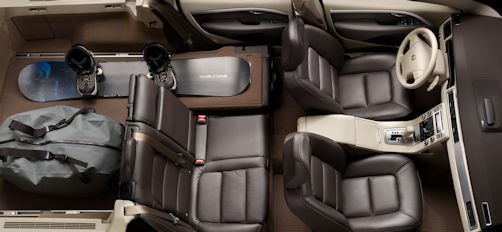
The rear seat splits 40/20/40, with two very comfortable seats and armrest in between. The centre backrest can be folded to make space for long cargo items or raised to provide an additional seat. The backrests can be folded separately to create a larger load compartment with an entirely flat floor.
The luggage compartment floor is equipped with aluminium rails and movable anchorage points to secure the load. The anchorage points can be tucked into the rails. The side panels also have built-in load anchorage eyelets to keep luggage securely in place. What is more, they can be supplemented with multifunctional rails for a variety of hooks, load-anchoring nets, cargo space dividers and other load-related accessories.
An extra sliding load floor is available as an accessory. It is fastened simply and quickly in the floor rails and slides out easily over the bumper to permit convenient loading. It is automatically locked into place when the handle is released. When it is not in use, the floor can easily be removed from the car altogether.
Power-operated tailgate. It is opened by pressing a button on the remote control, and the rest is handled by the car’s hydraulics, there is a dual-stage safety function integrated into the tailgate, involving an emergency stop, which means that the hydraulic system is equipped with a force sensor, stopping immediately if it senses an obstruction during operation.
Improved safety
The body structure is divided into zones, each of which has a different task during the deformation sequence. The outer zones are responsible for most of the deformation. The closer the collision forces get to the passenger compartment, the less the material deforms. In order to give each zone the right properties, different grades of steel are used in different structures, a total of four different grades. Apart from regular body steel, three different grades of high-tensile steel are used: High Strength Steel, Extra High Strength Steel and Ultra High Strength Steel.
To improve safety for children in the rear seat of the all-new XC70 model, Volvo has further developed the Side Impact Protection System (SIPS) with a stronger body structure, extended inflatable curtains and a height-adjustable integrated child booster cushion.The booster cushion, which is integrated in the rear seat, can be set at two heights, allowing children of different sizes to see out through the windows yet at the same time. The lower setting is intended for children between 115 and 140 cm in height and weighing between 22 and 36 kg, while the upper setting is designed for children measuring 95-120 cm and weighing between 15 and 25 kg. The all-new Volvo XC70 can be equipped with integrated child booster cushions in both outer rear seats.
The inflatable curtains in the all-new Volvo XC70 have been extended by 60 mm, which in combination with the height-adjustable booster cushions and the strong body side structure provide more children of different sizes with effective protection in a side impact.The front passenger airbag can be disabled using a key. What is more, the seat can be specified with attachments for rear-facing fitting of a child seat once the front passenger airbag is disabled.
- Improved child safety with extended IC (Inflatable Curtain) and integrated booster cushions
- New, stronger side structure
- Crumple zones made from different grades of steel
- Lower cross-member contributes to enhanced compatibility
- Compact transverse engines contribute to collision safety
- Second-generation WHIPS system
- Protection for other road users
- Other protective safety solutions
- Collapsing steering column which upon deformation moves horizontally for the best possible interaction with the airbag
- tPedals with a function that limits the risk of penetration into the passenger compartmen
- Airbags with two-stage function
- Seat belt pre-tensioners for all five seats
- Reinforced, transversely fitted tubular beam between the A-posts
- Strong SIPS tubes in the seats and a sturdy magnesium bracket in the middle of the car
- Diagonally fitted beams of Ultra High Strength Steel in the doors
In the middle of 2013, the XC70 was modified as part of a facelift. Here, Volvo changed the design of the radiator grille, which is characterized by a honeycomb-like structure henceforth. At the rear, the revised model differs by chrome strips under the tail lights and under the Volvo logo.
In mid-May 2016, the production of the XC70 finished.
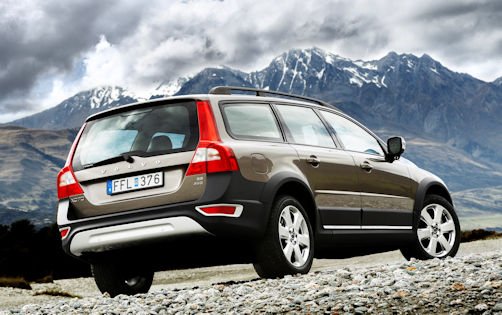
Technical
-
-Note: More Specifications and Repair Manuals available for registered users-
CHASSIS
Suspension
Front - Spring-strut, lower link,anti-roll bar
Rear - Individual Multi-link suspension, anti-roll barSteering - Rack and pinion, power assisted
Turning circle curb to curb - 11.5
Braking system - ABS system with EBD. Ventilated discs front and rear.
Braking distance 100-0 km/h - 39m
Brake disc diameter - 316/302 mmGear Ratios M66E H5A
First - 3.75
Second - 1.91
Third - 1.19
Fourth - 0.84
Fifth - 0.65
Sixth - 0.54
Reverse - 3.23Gear Ratios AW TF-80SC
First - 4.15
Second - 2.37
Third - 1.56
Fourth - 1.16
Fifth - 0.86
Sixth - 0.69
Reverse - 3.39ENGINES
Model Type - B6324S
Type -In-line 6 cyl, Normaly asp. petrol
Configuration - Transverse, all wheel drive
Displacement, cm3 - 3192
Bore (mm) - 84
Stroke (mm) - 96
Engine cylinder block material - Aluminium
Cylinderhead material - Aluminium
Compression ratio - 10.8
Valves, no/cylinder - 4
Camshafts - 2
Engine management system - Integrated fuel/ignition control systems
Ignition sequence - 1-5-3-6-2-4
Engine idling speed, rpm - 650
Fuel, rec. octane - 95-98 RON
Max output, kW (hp)/rpm. - 1 75 (238)/6200
Max torque, Nm/rpm. - 320/3200
Model Type - D5244T4
Type -In-line 5-cyl.turbo diesel
Configuration - Transverse, all wheel drive
Displacement, cm3 - 2400
Bore (mm) - 81
Stroke (mm) - 93.15
Engine cylinder block material - Aluminium
Cylinderhead material - Aluminium
Compression ratio - 17.3
Valves, no/cylinder - 4
Camshafts - 2
Engine management system - Electronically controlled common rail direct injection
Ignition sequence - 1-2-4-5-3
Engine idling speed, rpm - 700
Fuel, rec. octane - Min 48
Max output, kW (hp)/rpm. - 136 (185)/4000
Max torque, Nm/rpm. - 400/2000-2750model
capacity
cylinder
power
torque
construction
gasoline
3.2 AWD
3192 cc
R6
175 kW (238 hp) at 6200 min -1
320 Nm at 3200 min -1
08 / 2007-01 / 2008
T5
1969 cm³
R4
180 kW (245 hp) at 5500 min -1
350 Nm at 1500-4800 min-1
06 / 2013-05 / 2016
T6 AWD
2953 cc
R6
210 kW (285 hp) at 5950 min -1
400 Nm at 1500-4800 min-1
01 / 2008-10 / 2010
224 kW (304 hp) at 5600 min -1
440 Nm at 2100-4200 min-1
10 / 2010-06 / 2013
diesel
D3 * / D4
1984 cm³
R5
120 kW (163 hp) at 3500 min -1
400 Nm at 1500 to 2750 min -1
04 / 2010-06 / 2013
D3 AWD * / D4 AWD
2400 cc
R5
120 kW (163 hp) at 4000 min -1
420 Nm at 1750-2500 min-1
04 / 2010-11 / 2013
2.4D AWD
2400 cc
R5
120 kW (163 hp) at 4000 min -1
420 Nm at 1750-3000 min-1
11 / 2009-10 / 2010
2.4D (DRIVe)
2400 cc
R5
129 kW (175 hp) at 3000-4000 min -1
420 Nm at 1500 to 2750 min -1
04 / 2009-04 / 2010
D4
1969 cm³
R4
133 kW (181 hp) at 4250 min -1
400 Nm at 1750-2500 min-1
06 / 2013-05 / 2016
D4 AWD
2400 cc
R5
133 kW (181 hp) at 4000 min -1
420 Nm at 1750-2500 min-1
06 / 2013-05 / 2016
D5 AWD
2400 cc
R5
136 kW (185 hp) at 4000 min -1
400 Nm at 2000-2750 min-1
08 / 2007-03 / 2009
151 kW (205 hp) at 4000 min -1
420 Nm at 1500-3250 min-1
04 / 2009-05 / 2011
D5 AWD
2400 cc
R5
158 kW (215 hp) at 4000 min -1
420 Nm at 1500-3250 min-1
05 / 2011-03 / 2015
D5 AWD (Autom.)
440 Nm at 1500-3000 min-1
06 / 2011-03 / 2015
D5 AWD (Autom.)
2400 cc
R5
162 kW (220 hp) at 4000 min -1
440 Nm at 1500-3000 min-1
03 / 2015-05 / 2016
* Marketed until April 2012 as D3 / D3 AWD.
© Motor car History
